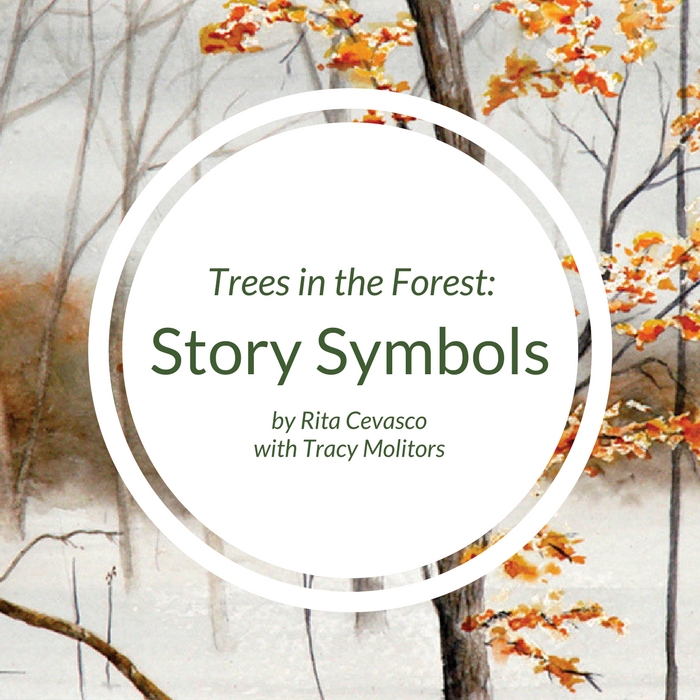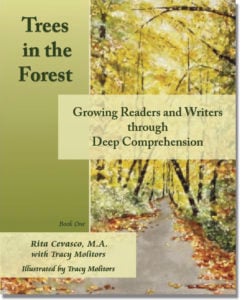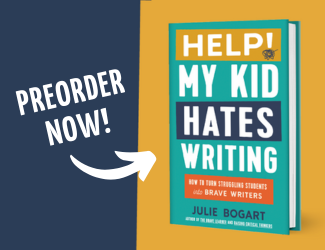Trees in the Forest: Day Four

by Rita Cevasco and Tracy Molitors
Day One: Laying a Path
Day Two: Bits & Pieces I
Day Three: Bits & Pieces II
“He was convinced you were going to ask him why he has trouble writing, so I think he was relieved when you talked about the brain and helping other kids (some who struggle more), allowing him to be honest about how he hates writing. Plus, you were so positive about his strengths and interests.” —Melissa, Homeschool Parent
Non-struggling readers and writers find it easier to match their writing skills to their thinking skills. They can achieve a flow from head (thoughts) to hand (writing on paper). Yet even those of us who easily flow from head to hand find writing in Bits and Pieces a great way to capture and stimulate our ideas.
Most children who struggle with reading and writing have perfectly wonderful thinking skills, but their writing skills cannot keep pace. For children who write more slowly than their thought process, Bits and Pieces of writing is a useful tool in helping them grow as independent writers. Bits and Pieces keeps the emphasis on their thoughts.
Lower output helps lower their struggle.
The Bits and Pieces of writing strategy also serves as a bridge from writing for your children to them writing independently. Even though we, as parents, applaud our children’s thinking skills, they become convinced of their abilities when they can write their ideas for themselves. In all things, kids believe real progress is defined by “I can do it myself”—from tying shoes to driving a car.
Cartooning Characters gives kids new ways to convey their ideas. This is empowering, especially since they are still learning how to analyze a story and interpret a writer’s message. Yesterday we gave attention to what our characters want. When we make personal connections with characters, we become more comfortable interpreting our character’s thoughts and desires. Once we understand our character’s thoughts and desires, our story’s conflict is revealed. As conflict is revealed, our story’s themes begin to rise to the surface.
One of the ways we gain insight into our story’s theme is by watching for symbolic language within a story. Today in Cartooning Characters, we will begin to identify our story’s symbols.
Some symbols are the result of the writer’s intentional efforts. Noticing these symbols, and the messages they represent, is important to understanding a story below the surface of the text. Other symbols occur in the head of the reader, based on personal experience. For instance, to some readers, a character’s car might represent socioeconomic standing or cool-factor, while others may disregard the car as unimportant. Some readers might resonate with a specific scene, so an item within that scene may be their choice to represent one of the story’s main ideas.
Remember: Symbols often point to themes. Recognizing themes in a story is easier when we identify not only the character’s conflict, as we explored yesterday, but also the story’s symbols, as we will explore today. Symbols are signs, so we want to imagine what our signs are saying. Like advertisements, they allow the writer to share the story’s sound-bites with us, the reader.
When we draw today with our children, we will look for symbols within our story, and then write a tag on the symbol to tell what the symbol signifies. Again, it may help to think about an important event in the story, and what items are in that scene. One of those items can become our symbol for important ideas in our character’s world. We will also create a sign for our character to carry—like a placard—broadcasting each character’s personal message to their world. We will again use Bits and Pieces of writing on signs and symbols to explore our story’s themes.
If you haven’t already, download the Cartooning Characters PDF to see how we encourage children to identify and interpret their character’s symbols. You will receive a packet that contains a blank drawing sheet, five days’ worth of activities labeled Day One through Day Five (each adding to the original drawing), and an example of Tracy’s completed cartoon for your reference.
We are on Day Four of the activity, so be sure to work up to that day. Tomorrow, we will give you insight into Day Five’s strategy. We will explain why the next step matters, so be sure to return to the blog. Spreading cartooning over many days allows us to revisit our character, each day digging deeper into our thoughts and writing a bit more.
DOWNLOAD Cartooning Characters
Trees in the Forest: Growing Readers and Writers through Deep Comprehension
by Rita Cevasco with Tracy Molitors
 Think deeply to write deeply. . . Geared to parents, educators and Speech Language Pathologists, this creative resource can be used to aid children in becoming lifelong readers and writers. Available in PDF or PRINT formats.
Think deeply to write deeply. . . Geared to parents, educators and Speech Language Pathologists, this creative resource can be used to aid children in becoming lifelong readers and writers. Available in PDF or PRINT formats.
For the digital PDF version:
Take $5.00 off at check out!
Enter Discount Code: RITA5
(expires January 31, 2017)
[This post contains an Amazon affiliate link. When you click on the link to make a purchase,
Brave Writer receives compensation at no extra cost to you. Thank you!]

















